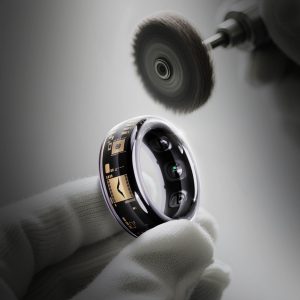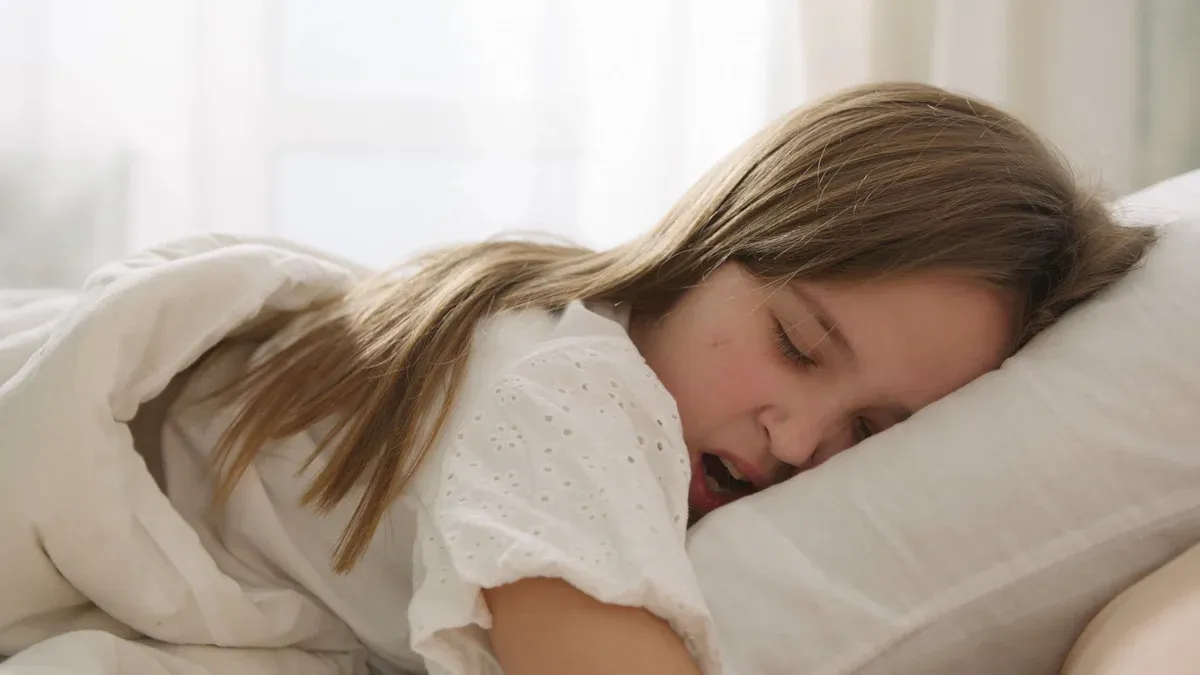
A normal sleeping heart rate depends on age. Adults usually have a normal sleeping heart rate between 40 and 60 beats per minute, while children have higher rates that decrease as they grow older. The table below shows typical ranges:
|
Age Group |
Normal Heart Rate Range (bpm) |
|---|---|
|
Newborn |
100 – 160 |
|
0-3 months |
70 – 170 |
|
6-12 months |
80 – 140 |
|
1-3 years |
80 – 130 |
|
3-5 years |
80 – 120 |
|
6-10 years |
70 – 110 |
|
11-14 years |
60 – 105 |
|
15 years or older |
60 – 100 |
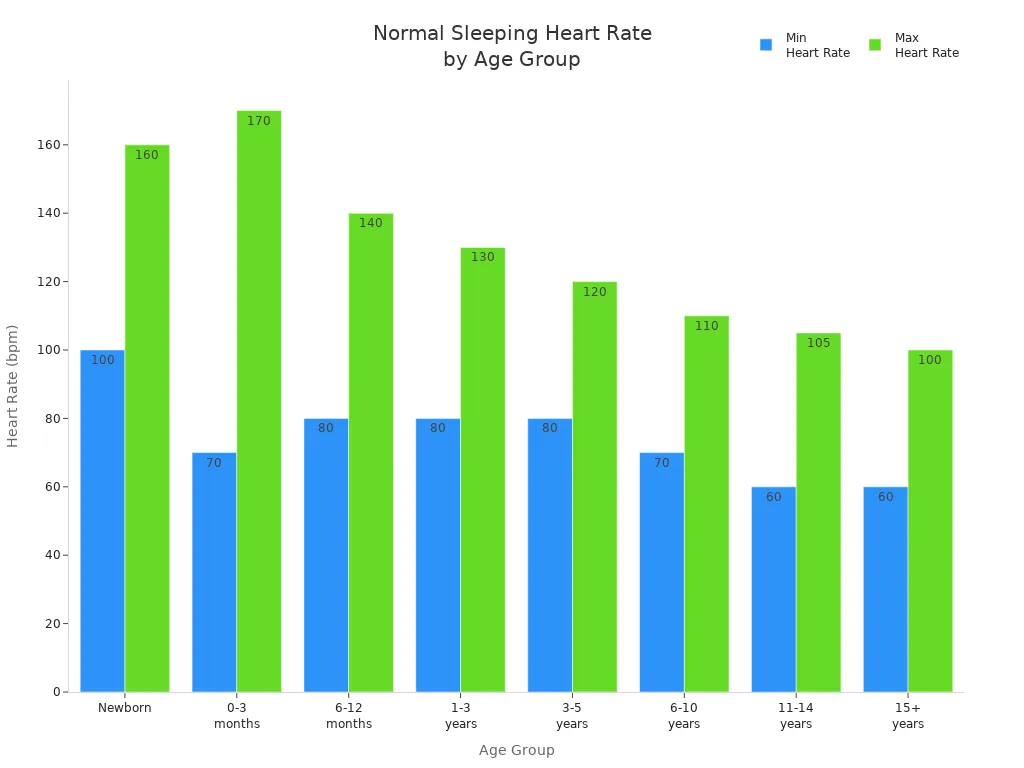
Monitoring sleeping heart rate can help spot early signs of health problems. Heart rates often change with age, activity, and health, so small variations are normal. Parents and adults can feel confident knowing that age plays a key role in what is healthy.
Key Takeaways
-
Normal sleeping heart rates change with age. Children have higher rates. These rates go down as they get older. Adults usually have 40 to 70 beats per minute.
-
Sleeping heart rate is lower than resting heart rate. This is because the body relaxes more during sleep. It is even lower in deep non-REM sleep.
-
Things like age, fitness, health, and lifestyle affect sleeping heart rate. Good habits help keep your heart healthy.
-
Wearable devices can track sleeping heart rate. This can help find health changes early. It can help adults and children get better care.
-
Having a regular sleep schedule helps your heart. Managing stress is important too. Exercise often and avoid bad habits. These things keep your sleeping heart rate healthy. They also help your whole body stay well.
Sleeping Heart Rate Basics
What Is Sleeping Heart Rate
Sleeping heart rate means how many times your heart beats each minute while you sleep. This number changes during the night as you go through different sleep stages. When you are in non-REM sleep, your body relaxes and your heart rate goes down. The parasympathetic nervous system gets more active and slows your heart. In REM sleep, your heart rate goes up and can change a lot. Sometimes, it gets close to what it is when you are awake.
|
Sleep Stage |
Autonomic Activity |
Heart Rate Change |
Mechanism Details |
|---|---|---|---|
|
Non-REM Sleep |
Increased parasympathetic, decreased sympathetic |
Heart rate decreases |
Vagal tone increases, sympathetic outflow drops, cardiovascular variability lowers |
|
REM Sleep |
Mixed sympathetic, decreased parasympathetic |
Heart rate increases |
Central modulation, more variability, muscle tone low |
|
Wakefulness |
Balanced sympathetic and parasympathetic |
Baseline heart rate |
Normal autonomic balance, higher sympathetic tone |
Your sleeping heart rate shows how your nervous system controls your heart at night. These changes happen because of your brain, not because you move or change position. Your heart rate is slowest during deep non-REM sleep. This helps your heart rest and recover.
Sleeping vs. Resting Heart Rate
Resting heart rate is how many times your heart beats each minute when you are awake, calm, and still. Sleeping heart rate is usually lower because your body is even more relaxed when you sleep. Both heart rates get lower as people get older and as fitness gets better.
|
Age Group |
Resting Heart Rate (bpm) |
Sleeping Heart Rate (bpm) |
Notes |
|---|---|---|---|
|
Adults |
60-100 |
40-70 |
Sleeping heart rate is 10-20% lower |
|
Well-trained Athletes |
40-60 |
Lower than typical adults |
Reflects high cardiovascular fitness |
|
Children |
70-190 |
Higher than adults, but lower than resting |
Both rates decrease with age |
Tip: If your sleeping heart rate is lower, it often means your heart is healthy and your body is recovering well while you sleep.
Resting heart rate is checked when you are awake but not moving. Sleeping heart rate goes down more when you reach deep sleep. Kids have higher heart rates than adults, but both numbers get lower as they grow up. Athletes can have much lower heart rates, which shows their hearts are strong and healthy.
Normal Sleeping Heart Rate
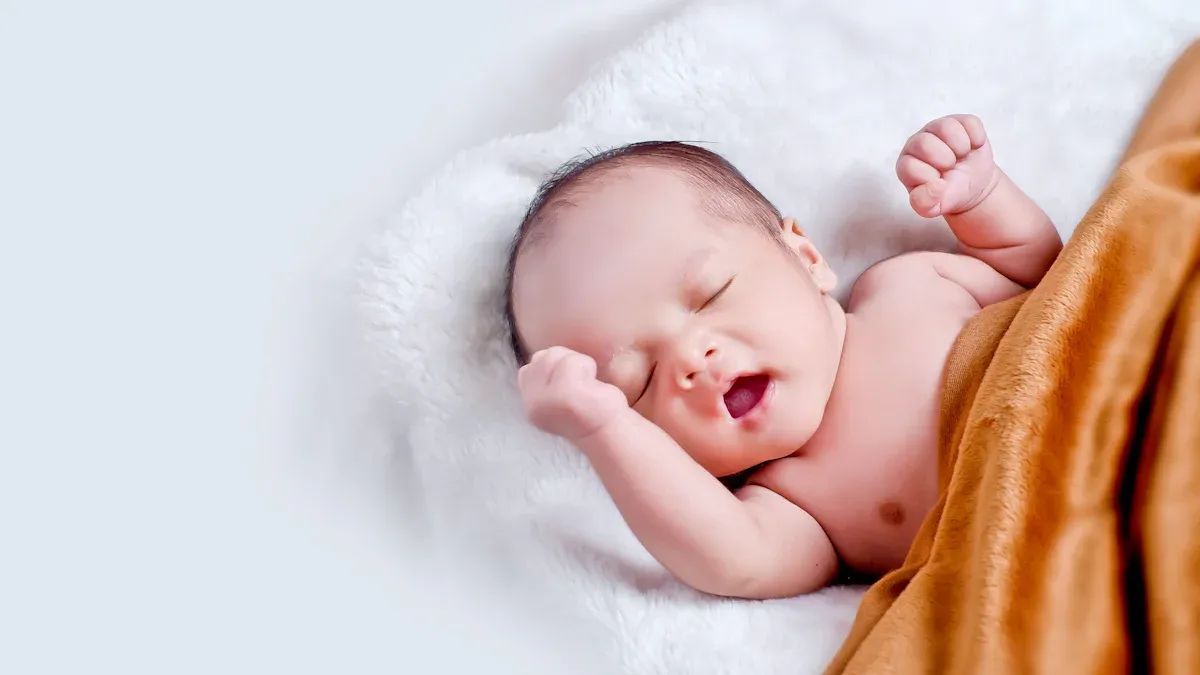
Adults
A normal sleeping heart rate for adults usually falls between 50 and 70 beats per minute. This range is about 10-20% lower than the resting heart rate during the day. Most healthy adults have a resting heart rate between 60 and 100 bpm, but the heart slows down at night as the body relaxes. Well-trained athletes often have even lower sleeping heart rates, sometimes reaching 40 to 60 bpm. Their hearts work more efficiently, so they do not need to beat as often to supply the body with oxygen.
Maintaining a normal sleeping heart rate helps the heart recover and supports overall health. If an adult’s sleeping heart rate drops below 40 bpm or rises above 100 bpm during sleep, it may signal a health problem, especially if symptoms like dizziness or fatigue appear. Regular exercise, stress management, and good sleep habits help keep the sleeping heart rate for adults within a healthy range.
Note: The normal heart rate for adults during sleep can change with age, fitness, and sleep stage. Deep sleep usually brings the lowest heart rate of the night.
Children by Age
Children have higher sleeping heart rates than adults. Their hearts beat faster because they are growing quickly and have smaller hearts. As children get older, their normal sleeping heart rate slowly decreases. Pediatric research shows that girls often have slightly higher heart rates than boys.
|
Age (years) |
Overall Mean HR (bpm) |
Male Mean HR (bpm) |
Female Mean HR (bpm) |
|---|---|---|---|
|
8 |
~81 |
~80 |
~82 |
|
9 |
~80 |
~78 |
~81 |
|
10 |
~79 |
~76 |
~81 |
|
11 |
~80 |
~79 |
~82 |
Children ages 6 to 11 usually have a normal sleeping heart rate between 70 and 83 bpm. Younger children and infants have even higher rates. The sleeping heart rate for children drops as they grow, but it stays higher than that of adults until the teenage years.
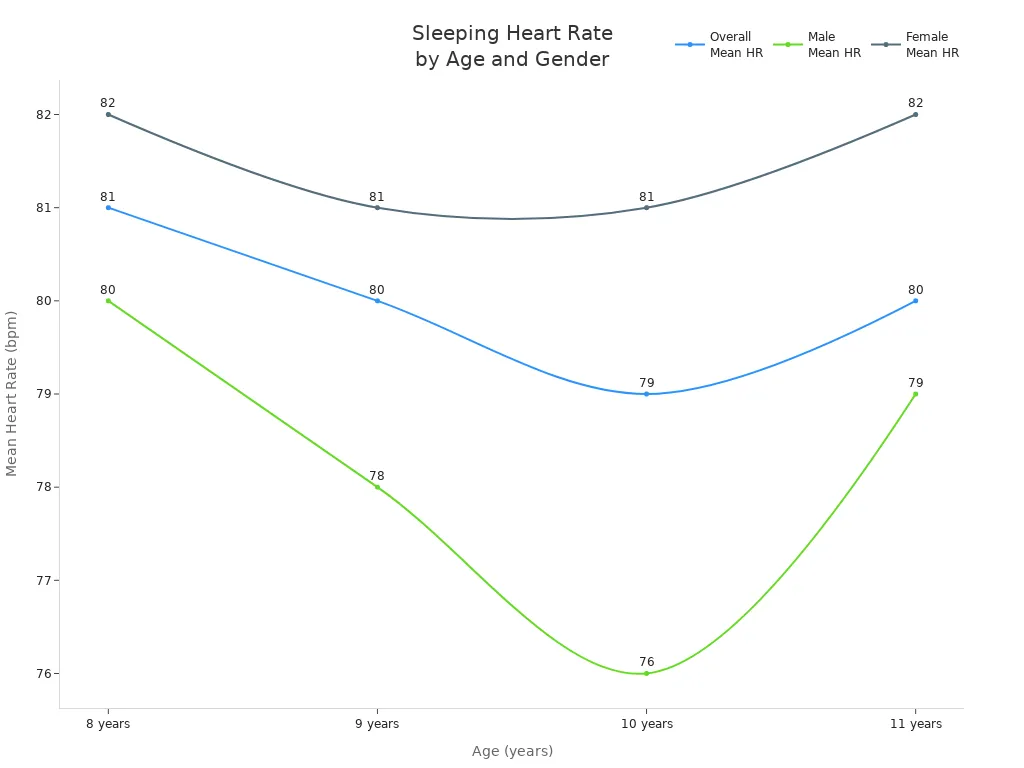
Tip: Parents can use these numbers to check if their child’s heart rate during sleep is within a normal range. Small changes are common and usually not a cause for concern.
Average Sleeping Heart Rate
The average sleeping heart rate changes with age. Infants and toddlers have the highest rates, while adults and seniors have the lowest. The table below shows the average sleeping heart rate by age group:
|
Age Group |
Average Sleeping Heart Rate (bpm) |
|---|---|
|
Newborns (0-1 month) |
70 – 190 |
|
Infants (1-11 months) |
80 – 160 |
|
Toddlers (1-2 years) |
80 – 130 |
|
Preschoolers (3-4 years) |
80 – 120 |
|
Children (5-6 years) |
75 – 115 |
|
Children (7-9 years) |
70 – 110 |
|
Children (10 years and older) |
60 – 100 |
|
Adolescents (10-19 years) |
60 – 100 |
|
Adults (20 years and older) |
60 – 100 |
|
Well-trained athletes |
40 – 60 |
This data shows that the normal heart rate for children is higher than for adults. As children grow, their average sleeping heart rate drops and becomes more stable. Adults have a lower and more consistent sleeping heart rate by age. Well-trained athletes have the lowest rates, showing strong heart health.
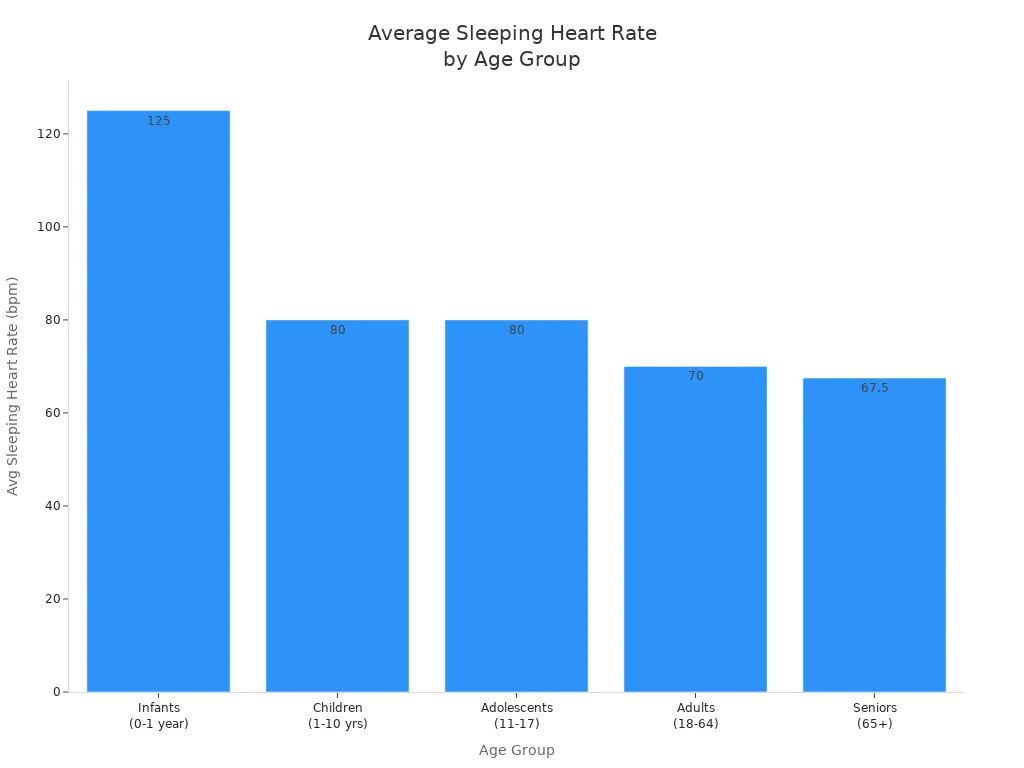
Callout: The difference between resting heart rate and sleeping heart rate is important. Resting heart rate is measured when a person is awake and calm, while sleeping heart rate is usually lower because the body is in its most relaxed state.
A normal sleeping heart rate helps the heart rest and recover. Tracking sleeping heart rate by age gives valuable information about heart health for both adults and children.
Factors Affecting Sleeping Heart Rate
Age
Age is important for sleeping heart rate. As kids get older, their sleeping heart rate goes down. For example, kids ages 2 to 6 see a drop of about 20 beats per minute. This happens because their hearts grow bigger and blood volume increases. It also takes longer for blood to move through the body. Girls usually have faster sleeping heart rates than boys. Some ethnic groups, like African American children, have higher rates than Caucasian children. Teens also see their sleeping heart rate go down as they age. Females often have faster rates than males. This is partly because of differences in fitness. Genetics also affects sleeping heart rate. It explains why people have different heart rates. These reasons show why normal heart rate is not the same for everyone.
Fitness
Physical fitness changes sleeping heart rate for kids and adults. Adults who exercise often have lower sleeping heart rates. Their hearts work better and do not need to beat as much. Teens with good fitness also have slower sleeping heart rates. This is especially true for boys. Athletes usually have the lowest sleeping heart rates. This means their hearts are strong and healthy. Regular exercise helps the heart get stronger.
Health Conditions
Some health problems can change sleeping heart rate. Common issues include:
-
Arrhythmia and other heart diseases
-
Thyroid disorders
-
Anemia
-
Use of certain medications
-
Chronic stress and anxiety
Kids may have respiratory sinus arrhythmia, which is usually normal. Some kids can get supraventricular tachycardia or other abnormal rhythms like Wolff-Parkinson-White syndrome. Sleep problems like sleep apnea can change heart rate during sleep. In adults, sleep apnea raises the risk of arrhythmias and sudden heart problems. In kids, treating sleep apnea can help heart rate and heart health.
Lifestyle
Lifestyle choices affect sleeping heart rate. Poor sleep, short sleep, and sleep problems like insomnia or sleep apnea can make heart rate go up at night. These issues raise stress hormones and nervous system activity. Eating healthy foods and having a balanced gut helps the heart. Stress and poor mental health can make sleep worse and raise heart rate. Good sleep habits, stress control, and healthy eating help keep heart rate normal. These things support health for kids and adults.
Tip: Small changes in daily habits can help your heart. Adults who sleep well, exercise, and eat healthy often have steady sleeping heart rates.
Measuring Sleeping Heart Rate
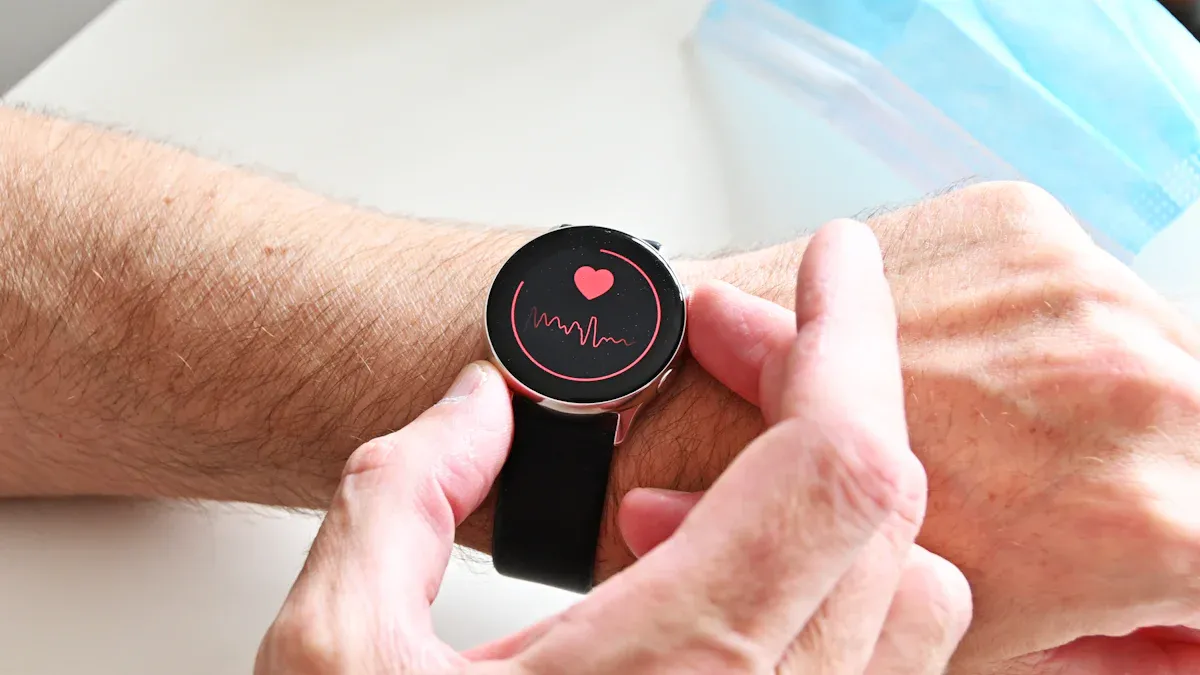
Methods
Doctors and scientists use different ways to check sleeping heart rate. The most exact way is called polysomnography, or PSG. Hospitals use PSG to watch heart rate, brain waves, breathing, and movement while you sleep. This test gives a lot of details but needs special tools and trained workers. It is mostly for people with big sleep problems.
At home, people can use other tools to check sleeping heart rate. Some popular choices are:
|
Method/Device |
Setting |
Accuracy/Limitations |
Notes |
|---|---|---|---|
|
Polysomnography (PSG) |
Clinical |
Very accurate, but expensive and not practical for daily use |
Used in hospitals and sleep clinics |
|
Home/Clinical |
Easy to use, but may overestimate sleep and miss wake periods |
Often used for sleep apnea screening |
|
|
Multisensor Wearables (e.g., smart rings) |
Home |
Good for tracking heart rate and movement, but accuracy can vary |
Comfortable for daily use |
|
Ballistocardiograph Sensors |
Home |
Measures heart and breathing movements; validated against PSG |
Placed under the mattress |
Wearable devices like the Vertu Smart Ring use special sensors and AI. They track heart rate, blood oxygen, and sleep patterns. These rings fit on your finger and work all night. They do not bother your sleep. Their shape makes them easy for adults and kids to wear. They give steady and correct data.
Home Monitoring
New technology makes it easier to check sleeping heart rate at home. Smart rings and other wearables let people track heart rate, sleep stages, and blood oxygen. These tools collect data every night and send it to a phone app. People can see changes over time and share reports with doctors or family.
Note: Tracking every night helps find slow health changes that one test might miss. Parents and adults can use this info to make better health choices.
Most healthy kids do not need home heart rate checks. Doctors say parents should follow safe sleep rules and talk to a doctor before using any device for babies. For adults and older kids, smart rings like the Vertu Smart Ring are comfy and look nice. They help people watch sleeping heart rate and health. These tools help families stay aware and support good health care.
Health Implications
Why It Matters
A healthy sleeping heart rate helps the heart rest and recover each night. When the heart beats at a steady, normal rate during sleep, it supports the body’s repair processes. For a healthy adult, a lower sleeping heart rate often means the heart is strong and efficient. Children also benefit from a healthy sleeping heart rate, as it supports growth and development. If the heart rate becomes too high or too low during sleep, it can signal problems such as stress, illness, or heart conditions. Tracking sleeping heart rate gives early clues about changes in health.
A healthy sleeping heart rate protects the heart and lowers the risk of future heart disease.
When to Seek Help
Sometimes, changes in sleeping heart rate need medical attention. People should watch for warning signs and talk to a healthcare provider if they notice any of the following:
-
The average sleeping heart rate stays above 100 beats per minute.
-
The heart rate drops below 60 beats per minute without a clear reason, such as being a healthy adult athlete.
-
Frequent heart palpitations happen with dizziness, shortness of breath, or chest pain.
-
Resting heart rate changes after starting new medicine.
-
Symptoms like chest pain, fainting, confusion, or severe fatigue appear.
If a sleeping heart rate falls below 40 beats per minute or drops to dangerous levels, especially with sleep disorders like sleep apnea, a doctor should check for underlying problems.
Tips for a Healthy Sleeping Heart Rate
People can take simple steps to support a healthy sleeping heart rate:
-
Exercise regularly with activities like walking, swimming, or cycling.
-
Manage stress using deep breathing, meditation, or relaxing hobbies.
-
Keep a steady sleep schedule to help the body’s natural rhythm.
-
Avoid caffeine, heavy meals, and screens before bedtime.
-
Create a calm, cool, and dark bedroom for better sleep.
-
Quit smoking and avoid recreational drugs.
-
Track sleeping heart rate with wearable devices for early detection of changes.
-
Treat health problems and talk to a doctor if symptoms appear.
-
Aim for 7–9 hours of sleep each night.
-
Address sleep disorders, such as sleep apnea or insomnia.
Regular exercise and healthy habits help the heart work better. Studies show that lifestyle changes, such as eating well, staying active, and managing stress, improve heart health for both children and adults. These steps help keep a healthy sleeping heart rate and support long-term wellness.
Studies show heart rate changes with age and sleep stage. It gets lowest during deep non-REM sleep. It goes up during REM sleep. Infants and kids have faster heart rates than adults. Older adults may see their heart rate go up a little again. Watching these changes can help keep your heart healthy. It can also help find problems early. New wearables like the Vertu Smart Ring make tracking easy and correct. They give you personal tips for your heart. Learning about these changes helps everyone take care of their heart at night. This can help you feel better and stay healthy.
FAQ
What is the difference between sleeping heart rate and resting heart rate?
Sleeping heart rate measures heartbeats per minute during sleep. Resting heart rate measures heartbeats per minute while awake and calm. Sleeping heart rate is usually lower because the body relaxes more deeply during sleep.
Can stress affect sleeping heart rate?
Yes, stress can raise sleeping heart rate. The body releases stress hormones that make the heart beat faster, even during sleep. Managing stress helps keep the heart rate in a healthy range.
How can someone check their sleeping heart rate at home?
People can use wearable devices like smart rings or fitness trackers. These tools measure heart rate all night and send the data to a phone app. The Vertu Smart Ring offers accurate and comfortable tracking.
Is a low sleeping heart rate always a sign of good health?
A low sleeping heart rate often shows strong heart health, especially in athletes. However, if someone feels dizzy, weak, or tired, a very low heart rate may signal a problem. A doctor should check unusual symptoms.
When should a parent worry about a child’s sleeping heart rate?
Parents should talk to a doctor if a child’s sleeping heart rate is much higher or lower than normal for their age, or if the child has symptoms like chest pain, fainting, or trouble breathing.




